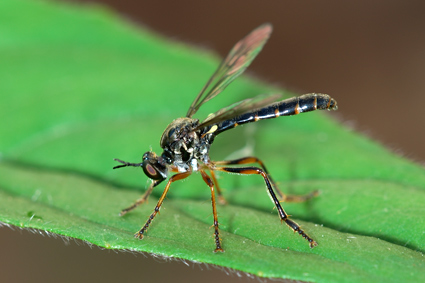Dioctriinae sensu Dikow 2009a

Dioctria hyalipennis , image © Michael Thomas.
Dioctriinae
– maxillary stipites divided medially (14)
– ommatidia all same size (46)
– setae on dorsal postpedicel present (55)
– apical “seta-like” sensory element situated subapically laterally on stylus (57)
– cell cup open (136)
– male hypandrium and epandrium not approximating, separated by gonocoxites (201)
– subepandrial sclerite with lateral protuberances (211)
The Dioctriinae, originally described by Enderlein (1936), was not applied as a higher-level taxon until re-erected by Lehr (2001). It is shown to be a distinct taxon from other Dasypogoninae and Stenopogoninae sensu previous authors in which Dioctriini has been placed (e.g., Hull 1962, Adisoemarto & Wood 1975, Artigas & Papavero 1991).
Dioctriini: Dioctria, Eudioctria, Nannodioctria
– metathoracic coxae with pointed, peglike protuberance anteriorly (113)
– macrosetae on lateral margin of frons (dorsal to antennal insertion) absent (49)
– male epandrium composed of a single sclerite, fused more or less entirely medially (197)
Echthodopini: Echthodopa
– mystax extending over lower facial half (7)
– sensory pit in distal maxillary palpomere present (12)
– antepronotum with macrosetae and setae (69)
– setae on superoposterior anepimeron present (86)
– macrosetae present on ventral metathoracic femora (116)
– female S8 platelike and slightly emarginate mediodistally (170)
– female spermathecal reservoir formed by more or less expanded and coiled ducts (180)
– male subepandrial sclerite without lateral protuberances (211)
– male lacking lateral ejaculatory process (213)
– male dorsal aedeagal sheath long and sperm sac entirely enclosed (215)
– male ventral median margin of dorsal aedeagal sheath strongly sclerotized and appearing entirely closed (217)
Genera not placed within above tribal taxa:
The Australian genus Broticosia is found to be the sister taxon to the remaining Dioctriinae. The genus Myelaphus is nested deeply within Dioctriinae as has been suggested before by Hull (1962) and Adisoemarto & Wood (1975). Artigas & Papavero (1991) placed it in Stenopogoninae: Ceraturgini along with Ceraturgus, which is considered to be a Brachyrhopalinae.
